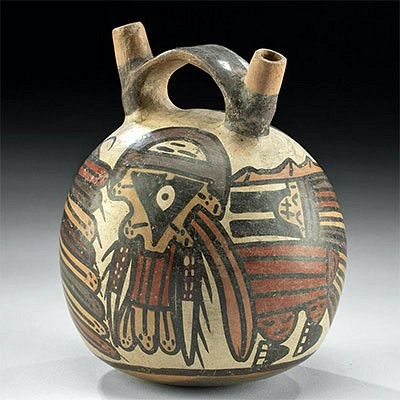Fine Zapotec Pottery Double Jar w/ Incised Deities TL'd
Lot 91d
About Seller
Artemis Gallery
686 S Taylor Ave, Ste 106
Louisville, CO 80027
United States
Selling antiquities, ancient and ethnographic art online since 1993, Artemis Gallery specializes in Classical Antiquities (Egyptian, Greek, Roman, Near Eastern), Asian, Pre-Columbian, African / Tribal / Oceanographic art. Our extensive inventory includes pottery, stone, metal, wood, glass and textil...Read more
Categories
Estimate:
$800 - $1,200
Absentee vs Live bid
Two ways to bid:
- Leave a max absentee bid and the platform will bid on your behalf up to your maximum bid during the live auction.
- Bid live during the auction and your bids will be submitted real-time to the auctioneer.
Bid Increments
| Price | Bid Increment |
|---|---|
| $0 | $25 |
| $300 | $50 |
| $1,000 | $100 |
| $2,000 | $250 |
| $5,000 | $500 |
| $10,000 | $1,000 |
| $20,000 | $2,500 |
| $50,000 | $5,000 |
| $100,000 | $10,000 |
| $200,000 | $20,000 |
About Auction
By Artemis Gallery
Feb 10, 2022
Set Reminder
2022-02-10 10:00:00
2022-02-10 10:00:00
America/New_York
Bidsquare
Bidsquare : Ancient & Ethnographic Art Through The Ages
https://www.bidsquare.com/auctions/artemis-gallery/ancient-ethnographic-art-through-the-ages-8873
Join us for Part Two of a spotlight on two fabulous collections, one from Lumberton, Texas, and the other from Whisnant Gallery in New Orleans. Artemis Gallery info@artemisgallery.com
Join us for Part Two of a spotlight on two fabulous collections, one from Lumberton, Texas, and the other from Whisnant Gallery in New Orleans. Artemis Gallery info@artemisgallery.com
- Lot Description
Pre-Columbian, southern Mexico, Oaxaca, Zapotec, Monte Alban IIIa, ca. 200 to 500 CE. A rare and fine example of a hand-built pottery vessel containing two conjoined cylindrical tubes with a mutual base. The broad composition shows each buffware vessel joined via the upper rim and lower base as well as deep interior cavities that perhaps held ink, pigment, or poison. Incised on the front of the righthand vessel is a glyph representing the deity 2 J (also known as the goddess Itzpapalotl) with a four-lobed framework and surrounded by petite circles. The front of the left-hand vessel exhibits an abstract anthropomorphic face, with a large mouth and narrow eyes, representing the deity 1 Tiger. Faint remains of red pigment are visible across scattered areas and allude to how attractive this was at one time. Size: 3.3" W x 3.875" H (8.4 cm x 9.8 cm)
This piece has been tested using thermoluminescence (TL) analysis and has been found to be ancient and of the period stated. A full printed and bound report is available for $50 to the buyer. Please contact us to request.
Provenance: private New Jersey, USA collection; ex-Arte Antico, New York, USA
All items legal to buy/sell under U.S. Statute covering cultural patrimony Code 2600, CHAPTER 14, and are guaranteed to be as described or your money back.
A Certificate of Authenticity will accompany all winning bids.
PLEASE NOTE: Due to recent increases of shipments being seized by Australian & German customs (even for items with pre-UNESCO provenance), we will no longer ship most antiquities and ancient Chinese art to Australia & Germany. For categories of items that are acceptable to ship to Australia or Germany, please contact us directly or work with your local customs brokerage firm.
Display stands not described as included/custom in the item description are for photography purposes only and will not be included with the item upon shipping.
#164023Restoration to roughly 1.5" to 2" of front of right chamber from rim downwards where incised glyph is present, with nearly invisible resurfacing and overpainting along new material and break lines. Minor nicks and abrasions to both chambers and incised details, with fading to most red pigment. Wonderful preservation to incised motifs. TL drill holes beneath base and inside of one rim. The letter "G" is written in graphite on the verso of one chamber.Condition
- Shipping Info
-
All shipping is handled in-house for your convenience. Your invoice from Artemis Gallery will include shipping calculation instructions. If in doubt, please inquire BEFORE bidding for estimated shipping costs for individual items.
-
- Buyer's Premium



 EUR
EUR CAD
CAD AUD
AUD GBP
GBP MXN
MXN HKD
HKD CNY
CNY MYR
MYR SEK
SEK SGD
SGD CHF
CHF THB
THB














